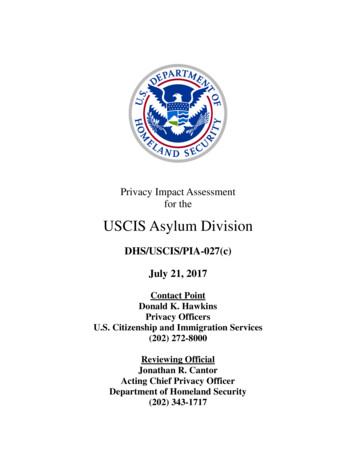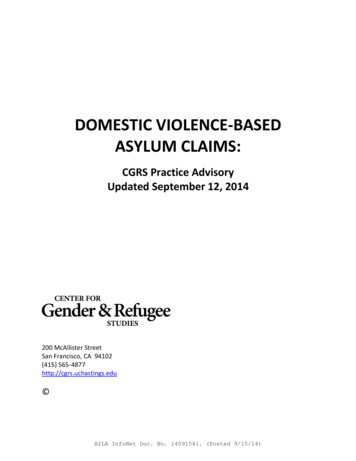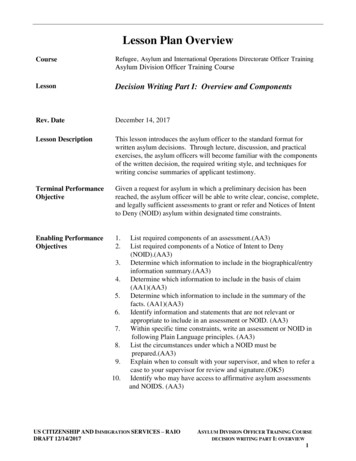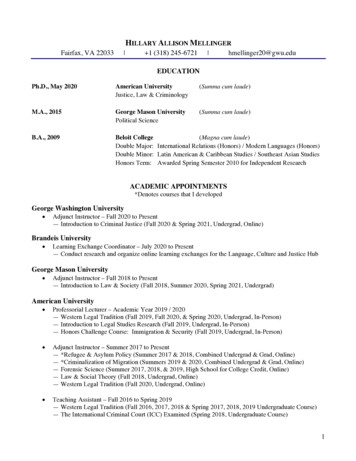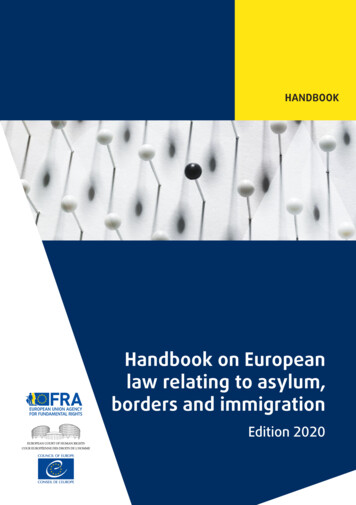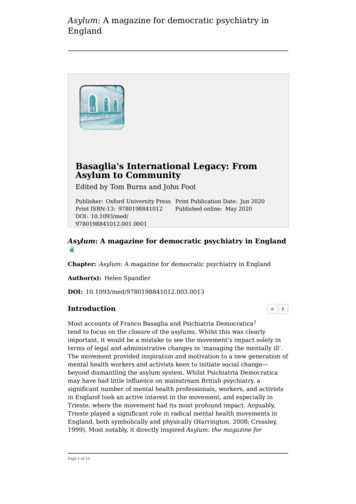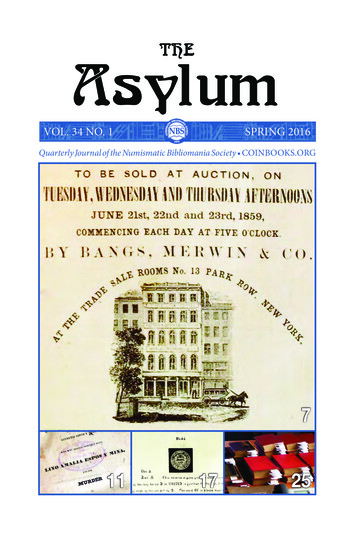
Transcription
THEAsylumVOL. 34 NO. 1SPRING 2016Quarterly Journal of the Numismatic Bibliomania Society COINBOOKS.ORG7111725
Books arethe lighthouseserected inthe great seaof time.Edwin P. Whipple1819—1886Kolbe & Fanning Numismatic Booksellers numislit.com (614) 414-0855 df@numislit.com
THEAsylumVOL. 34 NO. 1SPRING 2016Quarterly Journal of the Numismatic Bibliomania Society COINBOOKS.ORGTable of ContentsNBS NewsFeaturesPresident’sMessage . . . . . . . . . . 3The John K. Curtis Auction ofJune 21st 1859 . . . . . . . . . . . . . . . . . . . . . . . . . . . 7by P. Scott RubinFrom the Editor . . . . . 4To the Editor . . . . . . . 5NBS WikiRandom Page . . . . . 10NBS Flashback . . . . 23Member Survey . . . 23Numismatic EditorPanel and Forumat CSNS . . . . . . . . . 24A Walk On The (Literary) Wild Sidewith William E. Dubois . . . . . . . . . . . . . . . . . . . . . 11by Joel J. OroszOff The Shelf: Newcomb’s Bookon the Cents of 1801–03 . . . . . . . . . . . . . . . . . . . 17by David F. FanningBehind the Scenes at the NewmanNumismatic Portal . . . . . . . . . . . . . . . . . . . . . . . . 25by Len Augsburger
Numismatic Bibliomania Societycoinbooks.orgManaging Editor, The AsylumMaria Fanningnbsasylum@gmail.com141 W. Johnstown RdGahanna, OH 43230Editor-in-Chief, The AsylumElizabeth Hahn Bengelizzieitalia@yahoo.comNBS Membership/Subscriptions: The Asylum is mailed to all NBS Members. Membership is 25.00 inside the United States and 30.00 outside the U.S. New members receive one backissue plus all new issues upon publication. Requests for membership and change of addressshould be submitted to the Treasurer at the address below.Submissions: The Asylum (ISSN 1552-1931) is published in four issues per year. Submissionsshould be sent to the editor at nbsasylum@gmail.com. Authors, please put your name(s) andcontact information on all submitted material. All accepted manuscripts become the property ofthe Numismatic Bibliomania Society. For more information, please contact the editor.Advertising rates for 2016See our full Ad Rates and Guidelines at coinbooks.org/asylum or contact editor.Full page 120 5.5 x 8 inchesInside front, inside or outside back cover 125 5.5 x 8 inchesHalf page 75 5.5 x 4 inchesQuarter page 40 2.75 x 4 inches*A 10% discount may be applied for a full-year commitment. A 10% discount is available forNBS members and community organizations.Deadlines for Submissions and Advertising:Spring Issue (No. 1) February 1Summer Issue (No. 2) May 1Autumn Issue (No. 3) August 1Winter Issue (No. 4) November 1NBS 2016 OfficersPresidentMarc Ricardmcricard@yahoo.comVice-PresidentElizabeth Hahn Bengelizzieitalia@yahoo.comTreasurerTerry White terrywhite5475@yahoo.comP.O. Box 39, Hilliard, OH 43026-1278Board of GovernorsJohn W. Adams, Dover, MA jadams@canaccordgenuity.comLeonard Augsburger, Vernon Hills, IL leonard augsburger@hotmail.comDavid Fanning, Gahanna, OH df@numislit.comDan Hamelberg, Champaign, IL danhamelberg@aol.comSydney Martin, Doylestown, PA sfmartin5@comcast.netW. David Perkins, Centennial, CO wdperki@attglobal.netP. Scott Rubin, Lawrenceville, NJ numislit@msn.comEditor, E-SylumWayne Homren whomren@gmail.com 2016 Numismatic Bibliomania SocietyNBS HistorianJoel J. Orosz joeljorosz@gmail.comcoinbooks.org
President’s MessageMarc Ricard, NBS PresidentDear Friends,I would like to take this opportunity to welcome Maria Fanningas the new Editor of The Asylum. She is a talented and dedicatedprofessional who has agreed to manage all of the publication aspects of our fine journal into the future. She works with her husband, Board Member Dr. David Fanning, at Kolbe and FanningNumismatic Literature. Her position in the numismatic literaturecommunity makes her uniquely qualified for her new role, and theOfficers and Board of NBS are grateful for her service.I would also like to take this opportunity to thank our previous Editor, David Yoon, for his long tenure at The Asylum. Thepublication continuously improved under his leadership, and thequality of The Asylum is due in large part to his efforts. He hasbeen involved with Maria during the transition of roles, and forthat, and his service to NBS and the literature community overthe years, we are also very grateful.This is an exciting time to be involved in numismatic literature. With the rapid improvement of technology in publishingand archiving, many important works that previously would havebeen lost, are being preserved for future generations of collectors.Most of you are interested in building and improving your ownlibraries. The Numismatic Bibliomania Society continues to bethe best resource for information in our field.I look forward to seeing many of you at the World’s Fair ofMoney in Anaheim, CA in August. Much more on our Symposium, General Meeting, and Auction will be shared with you inthe near future. Stay tuned to the E-Sylum and this publicationfor details.With warmest regards,Marc Charles RicardCORRECTIONOnly rarely can I find an error to correct inThe Asylum. One appeared, however, in the October-December 2015 issue. In “A Modest Exoneration of B. Max Mehl’s “Hazeltine Type Table,’”the article’s author stated: “Dave Bowers remembers the ‘Texas Master of Coins’ belying his vividreputation by being personally colorless.”Dave Bowers never said or wrote this. The“colorless in terms of personality” assessment wasThe Asylum, Spring 2016made by John W. Adams in United States Numismatic Literature, Volume II, p. 55. The author obviously confused his numismatic icons in makingthe attribution.I have it on good authority that the authoris embarrassed, and will be much more carefulabout his accuracy in the future. Given his remorse, I’m inclined to forgive him.Joel J. OroszPage 3
From the EditorMaria Fanning,The Asylum EditorWelcome, fellow bibliomaniacs, to my editorial debut in The Asylum.Many of you may know me through my work at Kolbe & FanningNumismatic Booksellers and have met me at the ANA’s World’sFair of Money, the New York International Numismatic Convention or through email correspondence. I am pleased to be succeeding David Yoon, who has continued to produce an impressive publication for the past nine years. He has graciously offeredhis support and assistance in my first few issues and I thank himfor leaving me with a vibrant journal. I know we all wish him thebest for the future, be it in numismatics or archeology!The Asylum has a long history of being a hub of research anddiscussion for those serious about their love of numismatics. Ihope to draw on that passion to include even more contributionsfrom those we have not yet heard, as well as our excellent regularcontributors. There is plenty of room for those with a scholarlybent as well as inexperienced writers with a passion for numismatic books and we want to hear about yours.We have some fascinating articles in this issue. We are verylucky to have an article by P. Scott Rubin on his 19th-century auction catalogues, which we hope will become an ongoing series.We also have a spicy tale of love and murder written by no otherthan famed Mint Director William E. Dubois and brought tolight by our own Joel Orosz. David Fanning shares another of hisaward-winning “Off The Shelf ” columns, this one on Newcomb’sbook on 1801-03 cents, and Len Augsberger gives us an excitingupdate on what’s happening with the Newman Portal.Getting to Know YouTo get to know you all better I have put together a brief 10-questionmultiple-choice survey about your collecting and reading interests.I hope that you will indulge me for a few minutes so that I can tailorcontent to what you as NBS members want most to read. My ulterior motive is also to collect information on our readers’ specificareas of interest and collecting habits to share with potential advertisers and help expand and improve our journal. You can take thesurvey at https://www.surveymonkey.com/r/N295ZKS. Information will be kept anonymous. Your input is much appreciated!I am excited to meet all of our readers, whether in person or byemail, and would love to hear from all of you. If you have an ideafor a submission, please let me know as soon as possible so we canfit it into our editorial calendar. Please feel free to contact me atnbsasylum@gmail.com at any time with suggestions or contributions for future issues. Happy reading!Page 4The Asylum, Vol. 34 No. 1
To the EditorDear Editor,Every member of NBS is familiarwith the writings of Joel Orosz—hisscholarly research combined withhis eloquent style. However, noteveryone has heard Joel from thepodium, where he is just as scholarly and even more eloquent. The attached photographs depict the manin his role as Master of Ceremoniesat the recent ANS Gala. All hail ourtalented fellow bibliomaniac!Sincerely,Nom de PlumeThe Asylum, Spring 2016Page 5
Page 6The Asylum, Vol. 34 No. 1
The John K. Curtis Auctionof June 21, 1859Only the Fourth Coin Auction to realize over 1,000 before 1860.By P. Scott RubinStarting on June 21, 1859 and continuing until the 23rd of the month a coin auctionwas held at No. 13 Park Row, New York conducted by the auction house Bangs, Merwin & Co. The title of the sale was “Catalogue of a large and very choice collectionof Coins, Tokens and Medals (Ancient and Modern). Among the many gems in thiscollection are a large variety of American Gold and Silver Coins of rare dates, someof them proofs; - Complete sets of American Cents and Half Cents, many of themproofs; - Proof Patterns, Gold, Silver and Copper Pieces – Rare New Jersey, Connecticut, Vermont, Massachusetts and Virginia Cents and Half Cents, all fine – FineAmerican and Foreign Medals – English Coins and Tokens in Silver and Copper, &c.,&c.; Also a collection of rare AUTOGRAPH LETTERS and DOCUMENTS, &c. –The whole forming the finest collection ever offered in New York.”As can be seen by the lengthy title, this was to be a very important auction forthe time. However, missing from this title were the names of the cataloguer and anyconsigners. To modern researchers the answers to these questions are left to Emmanuel Joseph Attinelli, who in his 1876 book Numisgraphics (or the more recentversion by Quarterman Publications)1 we learn that this sale was sold in three partscontained in two publications. First, a 40-page catalogue containing the main part ofthe collection, followed by (starting on page 27) an Addenda that starts with new lotnumbers, and a two-page single-sheet second addenda which again starts with newlot numbers.From Attinelli we also learn that John K. Curtis 2 is the prime cataloguer and supplier of the lots in all three parts of this auction. Only the first 59 lots of the 333-lotfirst addenda were not his coins. These lots, according to Attinelli, belonged to A.M.Wilder, Thomas Walsh and E.M. Camp, and contained nothing of note.Some auction sales of the 19th century have been honored for their place in numismatic history. The November 1, 1858 Cogan sale is known for its ground-breakingsale of a set of U.S. cents and for being the first sale conducted by a full-time coindealer in the United States. However, some of the statements in the last sentenceare not really true. While it may be true that the sale was the first conducted by afull-time coin dealer, it was not a public auction as we know today. It was more likethe sales that were common when I started collecting coins in the 1950s: a dealerwould place a group of coins out on display, customers would write down their bestoffer, and the coins would be sold to the person who offered to pay the most by adate set by the dealer. Edward Cogan made a slight change in this system by setting a starting price, and his next two sales were handled in the same way. It wasThe Asylum, Spring 2016Page 7
The John K. Curtis Auction of June 21, 1859not until his October 28, 1859 sale of the W.C.Tripler collection did Cogan sell a collection atauction. With this sale he had an auctioneer:W.C. Cook was brought into Cogan’s store inPhiladelphia to call the auction. It should alsobe noted that in the case of the first four Cogan Sales no printed catalogues were availableat the time of the sale. Only manuscript copiesof the items offered and the prices they sold forexisted until the early 1860s when Attinelli reprinted Cogan’s second, third and fourth salesfrom hand-written copies. This was followedby Cogan’s reprinting of his first sale.This leads us to the fact that in the 1850s—the first decade of organized coin auctionstaking place in the United States—only threeindividuals who were considered coin dealersat the time held sales: Augustus Sage who was ateenager when he catalogued three auctions in1859 and an Addenda to one of his sales, Edward Cogan who, as shown above, did nothold an auction as we know it today until October 28, 1859, and John K. Curtis whoheld his first sale on June 21, 1859. After his initial burst of auctions Sage disappearedfrom the auction business and Curtis did not hold any significant sales after this firstone, but did keep a hand in the auction business until at least the early 1870s. Cogan,starting with his catalogue for his December 1859 auction, continued in the coin auction business until December 1879.This brings us back to the question of what makes this June 21–23, 1859 Bangs,Merwin & Co. auction so important. The answer lies in the contents of the sale itself.While the Cogan auction of October 1858 included a complete date set of large cents,that was about all it contained. This Curtis sale not only contained a complete date setof large cents but also had a nearly complete set of half cents along with a number ofduplicates of 1793 large cents and proof large cents of 1819, 1841, 1844, 1845, 1846,1848, 1854, 1855 and 1856. The silver American coins contained many of the classiccollectables such as 1794 silver dollar, 1796 15 star and half dollars, 1796 quarter anddime. Also included were gold coins such as eagles of 1799 and 1800, half eagles of1795, 1800, 1802, 1803, 1804, 1805,1806, 1807, 1808, 1809, 1810, 1811 and 1813 andmost important Quarter eagles of 1802, 1804, 1805, 1806, 1824, 1825, 1827, 1829,1830, 1831 and 1832. All the gold was called Proof, the 1799 Cent Almost Proof andthe 1804 Cent never circulated.Add to the above-mentioned regular issue United States coinage, California golddollar of 1853, and California gold half dollars of 1853 and 1856 (Octagon), alsopatterns including and 1852 ring gold dollar, 1854, 1855 and 1856 large and smallpattern cents, and two 1836 flying eagle silver dollars. Among the many other itemsof interest to collectors of American coinage were: a Massachusetts 1787 half cent, aRosa Ameri farthing UTILE DULCI 1722, large and small size Pine Tree shillings, anPage 8The Asylum, Vol. 34 No. 1
The John K. Curtis Auction of June 21, 18591787 Nova Eborac copper, a 1794 Talbot, Allum & Lee Token, a bar cent, a few 1787Fugio coppers, a 1785 Nova Constelatio with U.S. in Scrip, three New Jersey coppers:1787 E. PLURIBS, 1788 running fox (called dog) and a 1788 head left, a 1789 MottToken and finally a 1737 Higley copper with 3 sledge hammers. The rest of the collection contained many gold, silver and copper English coinage as well as gold and silvercoinage from other countries.In his groundbreaking book United States Numismatic Literature. Volume I: Nineteenth Century Auction Catalogs, John W. Adams did a wonderful job of detailing thehistory and contents of noted 19th-century coin dealers. In chapter 19 he departsfrom his method of identifying coin dealers’ auctions or, in some cases, fixed pricelists, to list auctions by the auction house that handled the sale, not by the individualswho did the sale, in this case Bangs & Co. Included in this listing is the John K. CurtisJune 21, 1859 sale with a rating of C . I do believe that while the inclusion of thissale is well-warranted it probably deserved a listing of at least a B, but I am not oneto argue with such a finely-researched work. Mr. Adams did such a wonderful job ofresearch on an unheralded body of work.It is also interesting to follow the Bangs Company name from its early start, especially in numismatic auctions3. Bangs & Co. was better known as a book auctioncompany who also handled other items for individual collectors or businesses. Manyof the well-known coin sales of the 19th century were sold by Bangs & Co. In fact,the first auctions by a member of the Bangs family originated in 1837 when LemuelBangs joined with James E. Cooley to open Cooley & Bangs. A year later the company changed with a new partnership under the name Bangs, Richards & Platt. In1849, the company changed again and became Bangs, Platt & Co. In 1851, Lemuel’sbrother Nathan Bangs joined the firm and the name was changed to Bangs, Brother& Co. In 1858, another reorganization of the firm gave us the name Bangs, Merwin &Co. In 1876, yet another reorganization of the firm saw its name changed to Bangs &Co. On April 1, 1903 the firm was sold to John Anderson, Jr. who was already in theauction business since 1900. By the fall of 1903 Anderson had combined both companies under the name Anderson Auction Co. In mid-1929 Anderson Auction Co.was consolidated with the American Art Association to become American Art Association Anderson Galleries. The firm went out of the business after the death of itslast owner and two of its chief employees; Mr. Parke and Mr. Bernet left to start theirown auction company which was later merged with Sotheby’s and still exists today asSotheby’s New York.I hope this story opens up more research into the early years of numismatic auctions and their value to collectors today.Notes1. Attinelli, Emmanuel Joseph. A BIBLIOGRAPHY OF AMERICAN NUMISMATIC AUCTION CATALOGUES, 1828-1875. Reprint. Lawrence: Quarterman, 1976.2. A person he identifies as a coin dealer with a shop on Bleecker St. who has been in businesssince 1857.3. Attinelli has their first coin related sale as March 17, 1841 when they were called BangsRichard and Platt.The Asylum, Spring 2016Page 9
A Random Page from the NBS WikiExplore the wiki and share your own research at wiki.coinbooks.orgPage 10The Asylum, Vol. 34 No. 1
A Walk On The (Literary) Wild Sidewith William E. DuboisJoel J. OroszNumismatically considered, William E. Dubois(1810-1881), like love, was a many-splendored thing.From one coigne of vantage, he was an exemplaryemployee of the mother Mint in Philadelphia, bothan accurate assayer, and a careful curator of the Mint’scabinet of rare coins. Espied from another angle, hewas the embodiment of nepotism run riot at the midcentury Mint. Still another glimpse of him reveals aserious scholar, the co-author of the first books written expressly for United States numismatists. Yetanother way of viewing him finds as pious aPresbyterian as a religious century ever produced. Now, we can add one more facet to thegemstone that was William E. Dubois, albeita facet that seems at first glance to be wildlyout of character: author of a tabloid-worthyaccount of an illicit love affair-cum-literallypoisonous murder plot.Any chronicler of William E. Dubois, nomatter how charitably inclined, must confront his family tree, which was a mighty oakthat, in the early days, virtually supported theUnited States Mint. During his long tenure,he could hardly hurl one of his cupels withoutit caroming off the noggin of one or anotherof his kith and kin. Dubois’ maternal grandfather, Robert Patterson, was the fourth Director of the Mint, and his uncle, Dr. SamuelMoore, was the fifth. William’s “uncle Sam”quite literally wanted him: to fill the positionof clerk at the Mint in September of 1833. Dr.Moore’s successor was Robert Patterson’s son,Robert Maskell Patterson, another of Dubois’uncles.All of that would be nepotism enough formost folks, but for William E. Dubois, thatTop to bottom: Adam Eckfeldt, Jacob R.was only the Patterson side of his work family. Eckfeldt and William E. Dubois: father,In 1836, Adam Eckfeldt, the venerable (and son, and son-in-law.The Asylum, Spring 2016Page 11
A Walk On The (Literary) Wild Side with William E. Duboisvenerated) Chief Coiner, requested Dubois’ services in the Assay Department, wherehe became Assistant Assayer working under Assayer Jacob Reese Eckfeldt, Adam’sson. Five years later, William married Adam’s daughter Susanna, thus gaining a ChiefCoiner for a father-in-law and an Assayer for a brother-in-law. The happy couple hada son, whom they named Patterson Dubois, in honor of the young man’s extendedfamily. Years later, when Patterson, too, came to work for the Mint, it seemed as if hewas related by blood to just about every living thing there with the exception of Peter,the mascot bald eagle.Keeping the nation’s coinage factory all in the Patterson/Eckfeldt family producedsurprisingly good results. The opening of a splendid new Mint edifice in 1833, and thefull embrace of steam-driven technology, made the American Mint at last a worthycounterpart to its older siblings in London and in Paris. The Jacob Eckfeldt/WilliamDubois team ran the Assay department with dependable efficiency, Eckfeldt being themore scientifically minded, and Dubois better at communicating results. In June of1838, William added another responsibility to his portfolio: becoming the first formalcurator of the Mint Cabinet of Coins, a collection informally started—it hardly needbe told—by a kinsman, Adam Eckfeldt. Dubois held that post for the rest of his life,proving to be such a canny collector that he is credited with forming the nucleus ofwhat is today the National Numismatic Collection of the Smithsonian Institution.The brothers-in-law also found the time to team-write themselves into the forefront of the American numismatic literature field, more than a decade before coincollecting took off as a mass hobby in the United States. Their debut literary production, A Manual of Gold and Silver Coins of All Nations, Struck Within the Past Century(1842), well-illustrated with the aid of Joseph Saxton’s medal-ruling machine, becamethe go-to reference work for aspiring collectors across the nation. The existence of the1804 dollar was announced to the world via its appearance on the second plate of thisbook. A second edition followed in 1849, and a third in 1851. Dubois went solo forhis next book, Pledges of History (1846), which provided the first written guide to thecontents of the Mint Cabinet. The California gold rush accelerated interest in numismatics, and in 1850, the in-laws were back together with New Varieties of Gold andSilver Coins, Counterfeit Coins, Bullion with Mint Values. This was a smaller volumethan their 1842 Manual, but it was enhanced by samples of actual California gold,placed under mica windows. The second and third editions, appearing respectively in1851 and 1852, sadly lacked the golden samples.Something else eventually was lacking in Dubois’ life, but this was by choice. Hisfather spelled the familial surname as good Huguenots would: Du Bois. As it did formany another descendant of old world immigrants, the temptation to simplify thespelling of the name proved irresistible. First the space was lost, and Du Bois becameDuBois. By the end of his life, William lost the second capitalization, as well, andDuBois became Dubois.William E. Dubois—assayer, author, curator—was obviously a big man on theMint’s campus, but when he went home to Susanna, he was also a pillar of the Presbyterian church. His father, the Rev. Uriah Du Bois, was a divine of considerablepiety, which trait was inherited by his descendants. William was “a devoted memberof the Presbyterian church,” according his obituary in the October 1881 issue of thePage 12The Asylum, Vol. 34 No. 1
A Walk On The (Literary) Wild Side with William E. DuboisTwo of Dubois’ numismatic titles,Pledges of History (1846) andNew Varieties of Coins and Bullion (1850).The Asylum, Spring 2016Page 13
A Walk On The (Literary) Wild Side with William E. DuboisAmerican Journal of Numismatics, written—it hardly need be told—by a kinsman, hisson Patterson. The same could said of Patterson, who wrote extensively on the moralformation of children. The Dubois men may have worked in a factory devoted tofacilitating mammon, but they were truly men of God.Which is why it is so surprising that in his father’s obituary, Patterson acknowledged William’s fling with the sensational in the formative years of his writing career:Schooled in the classics from the age of six, Mr. DuBois early developedliterary, linguistic, and antiquarian tastes, which soon turned productive.At sixteen, the weeklies welcomed his essays; as a tale writer, he foundmarked success in his twenties. A law student at twenty-two, he washighly commended for an able report of one of the most famous trials onrecord. Though soon after admitted to the bar, an encroaching weaknessof voice compelled him to relinquish the law. This affection was a crosspatiently borne through life .So, just what was this “able report of one of the most famous trials on record” that Dubois wrote while still a law student in 1832? The answer is found in the 148th Catalogof Rare Americana issued in early January of 2016 by David Lesser of Woodbridge,Connecticut. Lesser describes item 29 of his catalog as follows:DU BOIS, WILLIAM E.: TRIAL OF LUCRETIA CHAPMAN, OTHERWISE CALLED LUCRETIA ESPOS Y MINA, WHO WAS JOINTLYINDICTED WITH LINO AMALIA ESPOS Y MINA, FOR THE MURDER OF WILLIAM CHAPMAN, ESQ. LATE OF ANDALUSIA, COUNTY OF BUCKS, PENNSYLVANIA, IN THE COURT OF OYER ANDTERMINER, HELD AT DOYLESTOWN, FOR BUCKS, DECEMBERTERM, 1831, CONTINUED TO FEBRUARY TERM, 1832. PREPAREDFOR PUBLICATION BY WILLIAM E. DU BOIS, STUDENT OF LAW.Philadelphia: G.W. Mentz & Son, 1832.Clearly our William, 22 and a law student in 1832, was the author of this “able report.”But oh, how this report must have scandalized the fastidious denizens of the City ofBrotherly Love! Lesser’s summary of its contents, slightly condensed here, remain abit lurid even to our jaded 21st century ears:Lucretia, “past 40 and buxom,” according to Dubois, and Lino, a youngboarder who claimed to be the son of the Spanish Governor of California, became lovers. Obstructing their path to bliss was Lucretia’s “inconvenient” husband, William Chapman. Five weeks after he arrived, Linopurchased a quarter pound of arsenic from a Philadelphia druggist, explaining that he intended to stuff some birds. Instead, he used it to stuffthe unfortunate Mr. Chapman, who conveniently died within four days.The lovers slipped off quietly to be married in New York, but “Almostimmediately, the true character of the Spanish adventurer came out, withthe disappearance of the family silver and other obvious signs of his chicanery.” The police investigated, discovered that Chapman “was heavilyPage 14The Asylum, Vol. 34 No. 1
A Walk On The (Literary) Wild Side with William E. Duboisdosed with arsenic,” andarrested both Lucretiaand Lino.Though jointly indicted, thelovers were destined to haveseparate trials, with both proceedings found to be equallysensational in the eyes of thepublic. Lino was swiftly convicted and swung for his crime.Lucretia’s trial turned on thequestion of whether she hadconspired with Lino to poisonher husband. The jury, recoiling from the notion of hanginga woman, gave her the benefitof the doubt and acquitted herof the charge of murder.Thus did the “over 40 andbuxom” Lucretia get away withhomicide, and thus did herchronicler get away with writing a sensational page-turnerunder the cover of a trial commentary. Cynics may note thatthis was not the last time thatDubois produced legal fiction,for he assured owners of 1804dollars like Matthew Stickney Dubois’ report on the crime of the (19th) century.that their coins were “original”(that is, struck in 1804), which he knew to be untrue.Such assurances, however, were offered in Dubois’ weakened voice, and did notrise to the level of written affidavits. His Trial of Lucretia Chapman stands out asa walk on the wild side of writing by a man who habitually, in his published productions, stuck to the prim and proper. Yet one wonders, what might have been thecontents of the “tales” Dubois wrote when he was in his 20s? Were they moralisticparables in which virtue received its due, and evil was severely chastised? Or werethey ripping yarns of fetching maidens and murderous paramours? Further researchmay show that in his tales, as in so many other aspects of his life, William E. Duboistrod the straight and narrow path, but at least once, with the Trial of Lucretia Chapman, he leavened his piety with a spectacular dash of impropriety.The Asylum, Spring 2016Page 15
Figure 1: Newcomb’s 1925 study, The United States Cents of the Years 1801–1802–1803.Page 16The Asylum, Vol. 34 No. 1
Off the Shelf:Newcomb’s Book on the Cents of 1801–03by David F. FanningIn 1925, Howard R. Newcomb published The United States Cents of the Years 1801–1802–1803 (Figure 1).1 It was the first of three important volumes penned by Newcomb and George H. Clapp that did much to revitalize the study of early-date UnitedStates large cents.2 Newcomb would go on to pen his masterpiece United States Copper Cents, 1816–1857, which remained the standard work on the middle- and latedate cents until recent years.3Newcomb’s 1925 study was published in a tall quarto format, in an edition that hasbeen estimated at only 100 copies, but which was probably somewhat higher. It waswell-received, with Dr. Sheldon famously writing that the book “marks a milestonein the cent literature. Approaching a field which had been left almost in chaos by theDoughty book, Newcomb assembled a vast quantity of numismatic material, orderedand reordered it, finally set up a new classificational system and a list which seemedadequate; and after testing the new list for upwards of a decade, published. The verdict of time on this work has been favorable.”4 Th
The Asylum, Spring 2016 Page 3. President's Message. Marc Ricard, NBS President. Dear Friends, I would like to take this opportunity to welcome Maria Fanning as the new Editor of . The Asylum. She is a talented and dedicated professional who has agreed to manage all of the publication as-pects of our fine journal into the future. She works .


